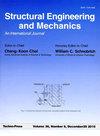基于模态曲率间隙平滑法和深度学习的结构损伤检测
IF 2.2
4区 工程技术
Q2 ENGINEERING, CIVIL
引用次数: 4
摘要
本文将间隙平滑法(GSM)与深度学习相结合进行损伤检测。卷积神经网络(CNN)是深度学习的一种模型。CNN有一个输入层、一个输出层和一些由卷积层组成的隐藏层。输入层是形状(图像数量)×(图像宽度)×(图像高度)×(图像深度)的张量。每次将激活函数应用于这个张量,该张量通过一个隐藏层,最后一层是完全连接层。在完全连接层之后,输出层是最后一层,由CNN进行预测。本文介绍了一个完整的机器学习系统。训练数据取自有限元(FE)模型。输入图像为曲率间隙光滑损伤指数等高线图。以自由-自由梁为例进行了研究。第一步,采用梁的有限元模型生成数据。然后将收集到的数据分成两部分,即70%用于训练,30%用于验证。在第二步中,使用训练数据对提出的CNN进行训练,然后使用可用数据进行验证。并在实验室进行了自由-自由支承条件下钢损伤梁的振动试验,对该方法进行了验证。共设置了15个加速度计来测量损伤梁的模态振型并计算其曲率间隙光滑。介绍了两种不同破坏程度的场景。结果表明,训练后的CNN能够成功地检测出实验损伤梁的损伤位置和损伤程度。本文章由计算机程序翻译,如有差异,请以英文原文为准。
Damage detection in structures using modal curvatures gapped smoothing method and deep learning
This paper deals with damage detection using a Gapped Smoothing Method (GSM) combined with deep learning. Convolutional Neural Network (CNN) is a model of deep learning. CNN has an input layer, an output layer, and a number of hidden layers that consist of convolutional layers. The input layer is a tensor with shape (number of images) × (image width) × (image height) × (image depth). An activation function is applied each time to this tensor passing through a hidden layer and the last layer is the fully connected layer. After the fully connected layer, the output layer, which is the final layer, is predicted by CNN. In this paper, a complete machine learning system is introduced. The training data was taken from a Finite Element (FE) model. The input images are the contour plots of curvature gapped smooth damage index. A free-free beam is used as a case study. In the first step, the FE model of the beam was used to generate data. The collected data were then divided into two parts, i.e. 70% for training and 30% for validation. In the second step, the proposed CNN was trained using training data and then validated using available data. Furthermore, a vibration experiment on steel damaged beam in free-free support condition was carried out in the laboratory to test the method. A total number of 15 accelerometers were set up to measure the mode shapes and calculate the curvature gapped smooth of the damaged beam. Two scenarios were introduced with different severities of the damage. The results showed that the trained CNN was successful in detecting the location as well as the severity of the damage in the experimental damaged beam.
求助全文
通过发布文献求助,成功后即可免费获取论文全文。
去求助
来源期刊

Structural Engineering and Mechanics
工程技术-工程:机械
CiteScore
3.80
自引率
18.20%
发文量
0
审稿时长
11 months
期刊介绍:
The STRUCTURAL ENGINEERING AND MECHANICS, An International Journal, aims at: providing a major publication channel for structural engineering, wider distribution at more affordable subscription rates; faster reviewing and publication for manuscripts submitted; and a broad scope for wider participation.
The main subject of the Journal is structural engineering concerned with aspects of mechanics. Areas covered by the Journal include:
- Structural Mechanics
- Design of Civil, Building and Mechanical Structures
- Structural Optimization and Controls
- Structural Safety and Reliability
- New Structural Materials and Applications
- Effects of Wind, Earthquake and Wave Loadings on Structures
- Fluid-Structure and Soil-Structure Interactions
- AI Application and Expert Systems in Structural Engineering. Submission of papers from practicing engineers is particularly encouraged.
 求助内容:
求助内容: 应助结果提醒方式:
应助结果提醒方式:


